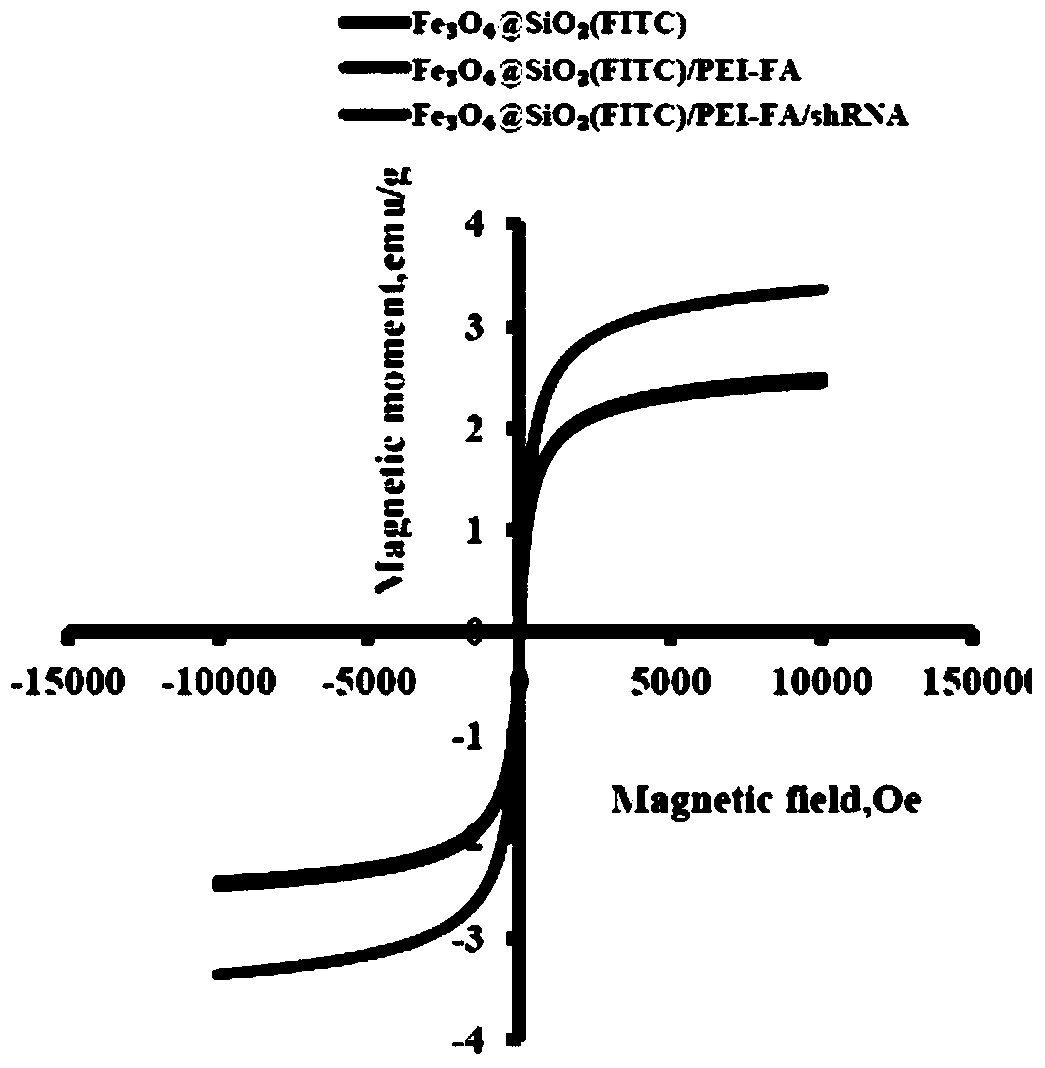Targeting magnetic fluorescent nano-vector carrying Notch-1 shRNA as well as preparation method and application of nano-vector
A technology of fluorescent nanometer and nanocarrier, which is applied in preparations for in vivo experiments, medical preparations with non-active ingredients, and pharmaceutical formulations, etc. It can solve the problems of loss of magnetism and low colloidal stability, and achieve low cost and long storage time. long-lasting and apoptosis-promoting effects
- Summary
- Abstract
- Description
- Claims
- Application Information
AI Technical Summary
Problems solved by technology
Method used
Image
Examples
Embodiment 1
[0031] Example 1: Synthesis of targeted magnetic fluorescent nanocarriers
[0032] ①The nanoparticles are Fe 3 o 4 as the core, with SiO 2 As the shell, and doped with fluorescent dye FITC, the surface of the carrier is modified with PEI-FA to adsorb Notch-1 shRNA gene. The schematic diagram of its synthesis is as figure 1 shown.
[0033] ②Nanoparticles have uniform particle size, regular shape, uniform spherical shape, particle size of about 60-70nm, and good dispersion in aqueous solution.
[0034] ③The nanoparticles not only have the functions of nuclear magnetic resonance imaging and fluorescence imaging. The surface-modified high-molecular polymer PEI-FA with targeting function can target human breast cancer cells (MDA-MB-231) with high folate receptor expression, release the carried gene, and silence the corresponding protein. Express.
Embodiment 2
[0035] Example 2: Fe 3 o 4 SiO 2 Preparation of (FITC) nanoparticles
[0036] ① Place 1ml of double distilled water, 1-5ml of magnetic fluid, 5-10ml of absolute ethanol and 200μl of ammonia water in a shaker at 300rpm for 10-30min.
[0037] ② Quickly add 5-10 μl tetraethyl orthosilicate (TEOS) to the above reaction system, keep away from light, place in a shaker, and shake at 300 rpm for 24 hours.
[0038] ③Add 1-5ml FITC-APTMS solution to the above reaction system, place it in a shaker, and continue shaking at 300rpm for 48h.
[0039] ④ Distribute the above solution evenly into EP tubes, centrifuge at 12000rpm for 5min, discard the supernatant, add 1ml of double distilled water, resuspend by ultrasonication, and wash with double distilled water for 5 times. Fe 3 o 4 SiO 2 (FITC) solid was dissolved in double distilled water and stored at 4°C until use.
[0040] The nanoparticles obtained in this example are uniform in size, uniform in spherical shape, good in dispersi...
Embodiment 3
[0041] Example 3: Fe 3 o 4 SiO 2 Preparation of (FITC) / PEI-FA / Notch-1 shRNA
[0042] ① Weigh 20 mg of folic acid powder, add 5 ml of DMSO to completely dissolve the folic acid, and the concentration is 4 mg / ml. Take 5-10ml of folic acid solution, add 4-10ml of DCC and 4-10ml of NHS respectively, place in a shaker at 300rpm, and shake for 10min.
[0043] ② Add an appropriate amount of PEI (20mg / ml) and continue shaking for 12 hours. After the reaction is completed, place the reactant in a dialysis bag and dialyze for 48 hours. And the liquid in the dialysis bag was placed in a glass bottle and freeze-dried.
[0044] ③Take 2 g of the dried solid and dissolve it in double distilled water to obtain a 20 mg / ml PEI-FA suspension
[0045] 4. first prepare Fe by the method of embodiment 2 3 o 4 SiO 2 (FITC).
[0046] ⑤ The above PEI-FA and Fe 3 o 4 SiO 2 (FITC) was mixed according to the mass ratio of 1:5-10, and the magnetic stirring speed was 300rpm for 2h. After the re...
PUM
| Property | Measurement | Unit |
|---|---|---|
| particle diameter | aaaaa | aaaaa |
| particle diameter | aaaaa | aaaaa |
Abstract
Description
Claims
Application Information
 Login to View More
Login to View More - R&D
- Intellectual Property
- Life Sciences
- Materials
- Tech Scout
- Unparalleled Data Quality
- Higher Quality Content
- 60% Fewer Hallucinations
Browse by: Latest US Patents, China's latest patents, Technical Efficacy Thesaurus, Application Domain, Technology Topic, Popular Technical Reports.
© 2025 PatSnap. All rights reserved.Legal|Privacy policy|Modern Slavery Act Transparency Statement|Sitemap|About US| Contact US: help@patsnap.com



